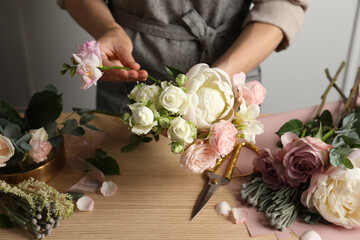Floral Artisans: Unveiling the Versatile Role of Florists Beyond Bouquets
Florists In DFW create flower arrangements for various occasions, including weddings, birthdays, holidays, and funerals. They use their creativity, knowledge of floral varieties, and design principles to craft beautiful and harmonious compositions.
Customer service is also a crucial component for florists. They must have exceptional communication skills to understand customers’ needs and translate them into workable bouquets.
Bridal Bouquets
 Whether you’re a bride who wants to go big or a bride who prefers a subtle, organic style, there are countless options for your bridal bouquet. The right wedding florist can translate your vision into a unique floral design that ties together all the elements of your big day.
Whether you’re a bride who wants to go big or a bride who prefers a subtle, organic style, there are countless options for your bridal bouquet. The right wedding florist can translate your vision into a unique floral design that ties together all the elements of your big day.
Traditionally, a hand-tied bridal bouquet is created in the hands of a florist and then tied with ribbon at the base to complete the look. This wedding bouquet style is especially popular with brides looking to create a more rustic, earthy look. It also allows the bride to customize her blooms and foliage without going over budget.
A more recent trend in the bouquet world is the hoop bouquet, which takes a circular base and then attaches blooms and greenery in a freestyle manner. This is often a popular option for boho-leaning or earthy weddings and can be very cost effective.
According to a florist a modern floral studio that specializes in event installations and editorial styling, the perfect bouquet is not only visually stunning, but it should also be comfortable for the bride to hold throughout the day. The bouquet should balance the weight of the dress and allow the bride to keep good posture.
In addition to the aesthetic of your bridal bouquet, consider what florals have meaningful meaning to you. For example, lilies of the valley are known to represent humility and new beginnings, while gardenias signify pure love. And of course, you can’t go wrong with including peonies on your wedding day—they symbolise romance, beauty and bashfulness.
If you’re planning to incorporate any sentimental items, be sure to let your wedding florist know so they can work them into your floral design. For instance, if you’re planning to carry something from your grandparents as your “something old,” your wedding florist can add it to your flowers for a truly special touch.
Boutonnieres
Florists create bouquets, centerpieces, corsages, and other floral arrangements to suit a variety of occasions. They work with fresh, dried, and artificial flowers to craft arrangements that are pleasing to the eye and appropriate for the occasion. They also have a deep understanding of flower varieties and design aesthetics, allowing them to craft harmonious compositions that meet customers’ needs and preferences.
They are also responsible for procuring and caring for flowers and other floral materials. This may include purchasing flowers from wholesalers or growers, inspecting the quality of the blooms, and conditioning the flowers to ensure they remain fresh and attractive for customer purchases. They also perform various flower arranging tasks, including trimming stems and crisscrossing them to create an overall arrangement, as well as assembling and packaging the finished product for delivery or pick-up.
Many florists operate their own shops, but they can also work for flower retailers, garden centers, and event planning companies. In addition, they can also find employment with wire services that broker national/online floral arrangement orders to local florists.
While a formal education is not required for most positions, most florists obtain their skills through on-the-job training. They typically begin in an entry-level position, such as a delivery driver or cashier, and advance into a floral design role with time. They must have excellent customer service and interpersonal communication skills, as they often interact with the public directly.
Some people who specialize in wedding floral design undergo specialized training at established flower schools or other post-secondary institutions. Others may receive informal training from seasoned florists who teach the art of floral design as a hobby or business. In addition, some communities offer classes taught by experienced florists to teach people interested in learning about the flower industry and how to create their own arrangements.
Centerpieces
The centerpiece is an integral part of a tablescape. Whether you choose a floral arrangement or another decorative option, it’s an excellent way to set the tone and give purpose to the rest of your decor. But it’s important not to go overboard. A centerpiece should be large enough to draw the eye, but not so big that it takes up all of the space on your guests’ tables. There should still be plenty of room for plates, glasses, napkins, and silverware.
When choosing a floral centerpiece, consider the height of your guests’ chairs and the overall size of the table. It’s also a good idea to choose a vase that complements your flowers. There are plenty of options available, including clear glass apothecary jars and glass cloches. You can also use natural decor such as coral, teak burls, or large seashells.
While many people use flower centerpieces as wedding reception decorations, they can also be used for baby showers, engagement parties, and anniversary celebrations. They are also a beautiful addition to Thanksgiving, Christmas, and Easter dinners.
While most florists specialize in fresh flower bouquets and arrangements, some also create stunning dry and silk flower arrangements that last well beyond the special event. Afloral is one of the best dry flower companies, with a sleek and modern online shop that makes it easy to find exactly what you’re looking for. They also offer custom arrangements and gift baskets, making it easier than ever to make your event extra-special.
Thanksgiving
Thanksgiving is an annual holiday observed in the United States to give thanks for the blessings of the harvest and the preceding year. The celebration is usually centered on a feast of traditional foods, including turkey, stuffing, gravy, sweet potatoes, corn, cranberry sauce and pumpkin pie. Other popular dishes vary by region and culture. The celebration is often accompanied by parades and football games. The day after Thanksgiving is known as Black Friday and features large sales.
The holiday began in 1621 when the Pilgrims of Plymouth, Massachusetts shared a harvest feast with their Native Wampanoag neighbors. This festival of gratitude became a national holiday when President Abraham Lincoln made it official by presidential proclamation in 1863 during the Civil War.
Throughout the country, family members come together to share a meal, watch a parade and attend church services. Some families take the opportunity to help others in need and donate food or money to charities. Other activities include watching football or other sports, taking long walks in nature, playing board or card games and taking naps.
Flower Girl NYC was started in 2004 by Denise Porcaro Tupper who specializes in modern bohemian style arrangements and floral crowns. The shop has a cozy feel and is located in the Lower East Side. The owner’s distinct style has gained popularity around the city and she also gives workshops for other floral designers. The shop is open 7 days a week and is one of New York City’s best. Customers can purchase flowers by the stem, join a subscription and even sign up for events and installations!
Christmas Wreaths
Wreaths are a staple decoration at Christmas and for many people, they are one of the most beloved holiday traditions. Many people don’t realize that there is actually a long and rich history behind these decorative and festive wreaths.
Throughout history wreaths have been used for various reasons and in many different ways, but they all hold a special significance. The first use of a wreath was during the pagan festival of Yule, which was celebrated at the winter solstice. During this time, people would hand craft these ring-shaped decorations out of branches, twigs, fruit and flowers. They would then hang them on their doors as a sign of victory. The circular shape was also representative of eternity or never ending life. When Christianity took over, they adopted the wreath tradition and used it to symbolize Christ.
Today, wreaths are commonly used at Christmas as a sign of joy and prosperity. They are typically made out of evergreen branches such as pine and holly and can be real or artificial. They are usually adorned with pine cones, berries, bows and other ornaments. They can be hung on the door or in a window and are often used as a centerpiece for the Christmas table. Some churches even incorporate them into their Advent ceremony by using a wreath with four candles lit each week leading up to Christmas.
The word wreath comes from the English term for “to twist” and this is very appropriate because of its history. The ancient Greeks awarded laurel wreaths to the winners of sporting events and the victors of battles. The Romans wore laurel wreaths as crowns on their heads and in the Persian empire, they were worn by the upper class and royalty.



